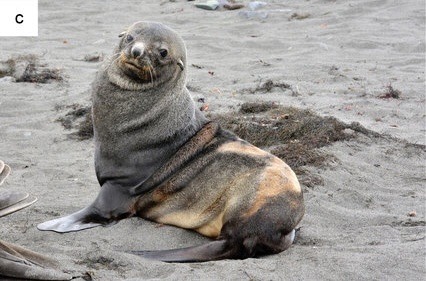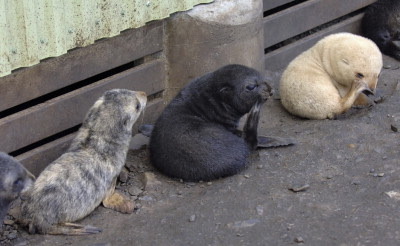Tsuki Oh How I Love You
tsuki oh how i love you

More Posts from Fursealfan and Others


sealed with a kiss 💋
casey and hogan - seattle aquarium
Today's Seals Are: Robot Uprising

kissy from mama
Sk'aliCh'elh-tenaut, also known as “Tokitae” or “Lolita”, was a Southern Resident killer whale likely from L-pod. She was born around the mid-1960s. Many suspect her mother is L25 “Ocean Sun”, but there has never been confirmation.
In August 1970, Sk'aliCh'elh-tenaut was one of around 80 killer whales rounded up for capture in Penn Cove, Washington. Based on her size, she was between 2-7 years old at the time. In the capture, led by Ted Griffin and Don Golsberry, 5 whales drowned and 7 whales, including Sk'aliCh'elh-tenaut, were taken away.
Sk'aliCh'elh-tenaut was purchased by a veterinarian at Miami Seaquarium named Jesse White for $20,000. She was transported to Miami Seaquarium in September 1970. White named her “Tokitae”, a Coast Salish word that roughly translates to “nice day” or “pretty colours” in English.
She was originally kept separately from the other orca, a male Southern Resident called Hugo. Hugo had been captured 2 years prior from Vaughn Bay, Washington.
Sk'aliCh'elh-tenaut and Hugo would often talk to each other between tanks, Southern Residents have a unique language which includes specific dialects within their pods, meaning that the two of them were able to communicate in ways that they could not with any other population. Miami Seaquarium eventually placed them together in a single 80-by-35 ft tank. The they mated often, but never had any living calves. Sk'aliCh'elh-tenaut was given the stage name “Lolita”.
Hugo experienced severe stress due to his situation. In March 1980, he died after ramming his head into the wall of the tank.
Sk'aliCh'elh-tenaut was housed with other cetaceans, but remained the only orca at the aquarium for the rest of her life. Despite her isolation, she held on to her home. She was heard multiple times throughout her decades in captivity singing a song that is only heard within L-pod.
In 2015, NOAA removed the exclusion of captive whales from the Endangered Species Act and included Sk'aliCh'elh-tenaut in the listing of Southern Residents. NOAA stated there was a “strong case” that she was a Southern Resident after analysing her mitochondrial and microsatellite DNA. However, because she was captured 2 years before the Marine Mammal Protection Act, Sk'aliCh'elh-tenaut was considered “pre-Act”, meaning she did not qualify under it.
The Lummi Nation never stopped fighting for Sk'aliCh'elh-tenaut to be brought home. They consider her a relative. In July 2019, two Lummi women, Squil-le-he-le and Tah-mahs, invoked the Native American Graves Protection and Repatriation Act (NAGPRA) in an attempt to bring Sk'aliCh'elh-tenaut home. NAGPRA gave them legal grounds to sue Miami Seaquarium if they refused to return Sk'aliCh'elh-tenaut to the Salish Sea.
In August 2019, the Lummi gave her the name “Sk'aliCh'elh-tenaut”, which roughly translates to “member of Sk’aliCh’elh” in English. Sk’aliCh’elh being a family of orcas in the Salish sea.
Squil-le-he-le visited Sk'aliCh'elh-tenaut in Miami and performed healing songs for her. Sk'aliCh'elh-tenaut was very receptive to this. Squil-le-he-le was quoted saying “She was singing with me. She was vocalizing with me,” in an interview with The Planet.
In March 2023, the Miami Seaquarium (now owned by The Dolphin Company) partnered with Friends of Toki and began the process of transferring Sk'aliCh'elh-tenaut to a sea pen in her home waters.
This decision was controversial given Sk'aliCh'elh-tenaut’s age (around her late 50s) and her chronic health conditions. She hadn’t been transported anywhere in over 50 years, causing concern for the stress that transport to Washington could cause her. There were also concerns that she might not be able to survive the re-exposure to the bacteria in the ocean after living in a tank of clorinated water for so long, or that she could possibly expose the wild Southern Residents to the infections she developed in captivity.
Others, especially the Lummi, argued that she deserved to live the remainder of her life in her home waters, which she clearly remembered.
In August 2023, the Miami Seaquarium announced that Sk'aliCh'elh-tenaut had passed away. Her cause of death was attributed to multiple chronic health conditions. On the day of her death, over 3000 miles away, members of all 3 Southern Resident pods (J,K, and L) were gathered together in what is known as a “superpod”. Gatherings of multiple Southern Resident pods have become more rare in recent years.
The Lummi were not consulted before the autopsy was performed.
Finally, in September 2023 her ashes were returned home and there were multiple ceremonies laying her to rest.
No Southern Resident had been seen in Penn Cove since the captures in the 1970s, but in November 2024, L-pod returned. Among them was Ocean Sun.
Footage: Kat Martin, ScubaFilmFactory, Miami Herald, KING 5 Seattle, AnaCarlaNJ, H2Omammals, DaddysJournie, KING 5 Seattle
Audio: Susannah Joffe, sacredsea.org
Begging you for some pinnipeds any pinnipeds please
Piebald Northern fur seal

Atypical colored Antarctic fur seal! With the orange, white, and grey they look calico.

Leucistic Antarctic fur seal

Interesting gang of Antarctic fur seal, one is leucistic and one almost looks brindle?

Leucistic southern elephant seal

Northern fur seal labeled as albino and partial albino (leucistic?) by some sources. NOAA says albino and they are experts.

Albino harbor seal

Albino ringed seal

Melanistic grey seal


lets kissy mama
potato chip’s old man groan…
via

“The Navigator”
Today's Seals Are: MAMA, LOOK!


"Eavesdropping on whale songs over the last six years is providing new information vital to answering questions about these giants of the ocean.
The number of whale songs detected is associated with shifting food sources, according to the California scientists—and the number of days humpbacks have been singing has nearly doubled.
When monitoring baleen whale songs in the Pacific Ocean, researchers found year-to-year variations correlated with changes in the availability of the species they forage on.
In vast oceans, monitoring populations of large marine animals can be a “major challenge” for ecologists, explained Dr. John Ryan, a biological oceanographer at the Monterey Bay Aquarium Research Institute in California (MBARI).
Their team deployed underwater microphones called hydrophones to study and track baleen whales, which communicate over long distances through sound.
“Surprisingly, the acoustic behavior of baleen whales provides insights about which species can better adapt to changing ocean conditions,” said Dr. Ryan, a lead author of the study.
They also monitored songs from blue, fin, and humpback whales off the West Coast of the U.S. to see what the song data could reveal about the health of their ecosystem.
The findings, published in the journal PLOS One, showed “large” year-to-year variations in whale song detection.
“The amount of humpback whale song continually increased, with their songs being detected on 34% of days at the beginning of the study and rising to 76% of days after six years,” said Dr. Ryan.
“These increases consistently tracked improved foraging conditions for humpback whales across all study years—large increases in krill abundance, followed by large increases in anchovy abundance.
“In contrast, blue and fin whale song rose primarily during the years of increasing krill abundance.
“This distinction of humpback whales is consistent with their ability to switch between dominant prey. An analysis of skin biopsy samples confirmed that changes had occurred in the whales’ diets.”
He explained that other factors, including the local abundance of whales, may have contributed to patterns in song detections observed in some years, but changes in foraging conditions were the most consistent factor.
“Overall, the study indicates that seasonal and annual changes in the amount of baleen whale song detected may mirror shifts in the local food web.”
WHALES ON THE COMEBACK TRAIL: • Gray Whale, Extinct for Centuries in Atlantic, Is Spotted in Cape Cod • Sighting of Many Blue Whales Around Seychelles is First in Decades – ‘Phenomenal’ • Majestic Sei Whales Reappear in Argentine Waters After Nearly a Century
“The results suggest that an understanding of the relationship between whale song detection and food availability may help researchers to interpret future hydrophone data, both for scientific research and whale management efforts”, which could better protect endangered species."
-via Good News Network, March 1, 2025
-
 tearyeyedsealpup liked this · 2 weeks ago
tearyeyedsealpup liked this · 2 weeks ago -
 spinydogfish reblogged this · 2 weeks ago
spinydogfish reblogged this · 2 weeks ago -
 spinydogfish liked this · 2 weeks ago
spinydogfish liked this · 2 weeks ago -
 3am-seraphim liked this · 3 weeks ago
3am-seraphim liked this · 3 weeks ago -
 kroster-strudel liked this · 3 weeks ago
kroster-strudel liked this · 3 weeks ago -
 sythrynn liked this · 3 weeks ago
sythrynn liked this · 3 weeks ago -
 enchantingartisancycle liked this · 3 weeks ago
enchantingartisancycle liked this · 3 weeks ago -
 grapehater liked this · 3 weeks ago
grapehater liked this · 3 weeks ago -
 erdbeersiegel liked this · 3 weeks ago
erdbeersiegel liked this · 3 weeks ago -
 fluffywolfboyy liked this · 3 weeks ago
fluffywolfboyy liked this · 3 weeks ago -
 winterbirch liked this · 3 weeks ago
winterbirch liked this · 3 weeks ago -
 pockettron3000 liked this · 3 weeks ago
pockettron3000 liked this · 3 weeks ago -
 captain-rosehip liked this · 3 weeks ago
captain-rosehip liked this · 3 weeks ago -
 dizzyseal liked this · 3 weeks ago
dizzyseal liked this · 3 weeks ago -
 blebo-blorp liked this · 3 weeks ago
blebo-blorp liked this · 3 weeks ago -
 the-heretical-knight liked this · 3 weeks ago
the-heretical-knight liked this · 3 weeks ago -
 znackbug liked this · 3 weeks ago
znackbug liked this · 3 weeks ago -
 garlic-gal liked this · 3 weeks ago
garlic-gal liked this · 3 weeks ago -
 autistic-dragons-for-life liked this · 4 weeks ago
autistic-dragons-for-life liked this · 4 weeks ago -
 rosahaus63 liked this · 4 weeks ago
rosahaus63 liked this · 4 weeks ago -
 bambibaddie liked this · 4 weeks ago
bambibaddie liked this · 4 weeks ago -
 yrboy09 liked this · 4 weeks ago
yrboy09 liked this · 4 weeks ago -
 artioprotection liked this · 4 weeks ago
artioprotection liked this · 4 weeks ago -
 bingoary reblogged this · 4 weeks ago
bingoary reblogged this · 4 weeks ago -
 bingoary liked this · 4 weeks ago
bingoary liked this · 4 weeks ago -
 grubgirl413 liked this · 4 weeks ago
grubgirl413 liked this · 4 weeks ago -
 turboshoorp420 liked this · 4 weeks ago
turboshoorp420 liked this · 4 weeks ago -
 butchseal liked this · 4 weeks ago
butchseal liked this · 4 weeks ago -
 good-luck-des reblogged this · 4 weeks ago
good-luck-des reblogged this · 4 weeks ago -
 good-luck-des liked this · 4 weeks ago
good-luck-des liked this · 4 weeks ago -
 archiearchiearchiearchie reblogged this · 4 weeks ago
archiearchiearchiearchie reblogged this · 4 weeks ago -
 femmeseal reblogged this · 4 weeks ago
femmeseal reblogged this · 4 weeks ago -
 femmeseal liked this · 4 weeks ago
femmeseal liked this · 4 weeks ago -
 myasoko liked this · 4 weeks ago
myasoko liked this · 4 weeks ago -
 my-coven-is-claudia liked this · 4 weeks ago
my-coven-is-claudia liked this · 4 weeks ago -
 emoscot liked this · 4 weeks ago
emoscot liked this · 4 weeks ago -
 k2j2s liked this · 4 weeks ago
k2j2s liked this · 4 weeks ago -
 sub-vester liked this · 4 weeks ago
sub-vester liked this · 4 weeks ago -
 micarps reblogged this · 4 weeks ago
micarps reblogged this · 4 weeks ago -
 micarps liked this · 4 weeks ago
micarps liked this · 4 weeks ago -
 luciferthycryptoidiii liked this · 4 weeks ago
luciferthycryptoidiii liked this · 4 weeks ago -
 shelvis-presley liked this · 4 weeks ago
shelvis-presley liked this · 4 weeks ago -
 sealgirltummy liked this · 4 weeks ago
sealgirltummy liked this · 4 weeks ago -
 bunniehunn liked this · 4 weeks ago
bunniehunn liked this · 4 weeks ago -
 rainesol reblogged this · 4 weeks ago
rainesol reblogged this · 4 weeks ago -
 rainesol liked this · 4 weeks ago
rainesol liked this · 4 weeks ago -
 froggoingferal liked this · 4 weeks ago
froggoingferal liked this · 4 weeks ago -
 pomogando liked this · 1 month ago
pomogando liked this · 1 month ago
